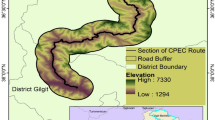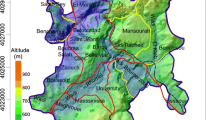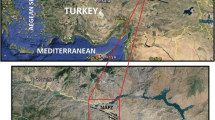Abstract
The objective of this study is to perform a preliminary national-scale assessment of the landslide susceptibility of rock-cut slopes along expressways in Korea. A geographic information system (GIS) database was compiled based on data from topographical and geological maps, and rock-cut slope data, including the locations of past landslides. Seven factors (i.e., slope height, slope length, slope gradient, upper slope gradient, lithology, distance from nearest fault, and dip direction of slope) were extracted from the GIS database to assess the relationship between each factor and landslide events. Weight of evidence (WOE), analytic hierarchy process (AHP), and fuzzy logic methods, as well as hybrid methods, were used to establish the rating of classes for each factor, weightings for the factors, and to combine multiple factor layers into landslide-susceptibility maps. A comparison of the results obtained using several different methods, based on the area under curve technique, revealed that the WOE method showed the highest accuracy of 74%. The annual cost of traffic congestion resulting from slope failures was evaluated to identify those rock-cut slopes where detailed investigations and landslide warning systems are required.







Similar content being viewed by others
References
Akgun A, Dag S, Bulut F (2008) Landslide susceptibility mapping for a landslide-prone area (Findikli, NE of Turkey) by likelihood-frequency ratio and weighted linear combination models. Environ Geol 54:1127–1143
Ayalew L, Yamagishi H, Marui H, Kanno T (2005) Landslides in Sado Island of Japan. Part II. GIS-based susceptibility mapping with comparisons of results from two methods and verifications. Environ Geol 81:432–445
Bascetin A (2007) A decision support system using analytical hierarchy process (AHP) for the optimal environmental reclamation of an open-pit mine. Environ Geol 52:663–672
Canuti P, Focardi P, Garzonio CA (1985) Correlation between rainfall and landslides. Bull Eng Geol Environ 32:49–54
Chacon J, Irigaray C, Fernandez T, El Hamdouni R (2006) Engineering geology maps: landslides and geographical information systems. Bull Eng Geol Environ 65:341–411
Chen CH, Ke CC, Wang CL (2009) A back-propagation network for the assessment of susceptibility to rock slope failure in the eastern portion of the Southern Cross-Island Expressway in Taiwan. Environ Geol 57:723–733
Cho H, Lee D (2006) 2004 traffic congestion cost: estimation and trend analysis. The Korea Transport Institute, Policy Research 2006-01, pp 1–23
Cruden DM, Varnes DJ (1996) Landslide types and processes. In: Turner AK, Schuster RL (Eds) Landslides, investigation and mitigation. Transportation Research Board, National Research Council, Special Report 247. National Academy Press, Washington, DC, pp 36–75
Dahal RK, Hasegawa S, Nonomura A, Yamanaka M, Masuda T, Nishino K (2008) GIS-based weights-of-evidence modeling of rainfall-induced landslides in small catchments for landslide susceptibility mapping. Environ Geol 54:311–324
Ercanoglu M, Gokceoglu C (2002) Assessment of landslide susceptibility for a landslide-prone area (north of Yenice, NW Turkey) by fuzzy approach. Environ Geol 41:720–730
Gomez H, Kavzoglu T (2005) Assessment of shallow landslide susceptibility using artificial neural networks in Jabonosa River Basin, Venezuela. Eng Geol 25:11–27
Kamp U, Growley BJ, Khattak GA, Owen LA (2008) GIS-based landslide susceptibility mapping for the 2005 Kashmir earthquake region. Geomorphology 101:631–642
Kanungo DP, Arora MK, Sarkar S, Gupta RP (2006) A comparative study of conventional, ANN black box, fuzzy and combined neural and fuzzy weighting procedures for landslide susceptibility zonation in Darjeeling Himalayas. Eng Geol 85:347–366
Keller EA, Blodgett RH (2007) Natural hazards: Earth’s processes as hazards, disasters, and catastrophes. Pearson Prentice Hall, New Jersey
Ko Ko C, Flentje P, Chowdhury R (2004) Landslides qualitative hazard and risk assessment method and its reliability. Bull Eng Geol Environ 63:149–165
Kumar A, Sanoujam M (2007) Landslide studies along the national Expressway (NH39) in Manipur. Nat Hazard 40:603–614
Lee S (2007) Application and verification of fuzzy algebraic operators to landslide susceptibility mapping. Environ Geol 52:615–623
Lee S, Talib JA (2005) Probabilistic landslide susceptibility and factor effect analysis. Environ Geol 47:982–990
Neuhauser B, Terhorst B (2007) Landslide susceptibility assessment using “weights-of-evidence” applied to a study area at the Jurassic escarpment (SW-Germany). Geomorphology 86:12–24
Oh HJ, Lee S, Chotikasathien W, Kim CH, Kwon JH (2008) Predictive landslide susceptibility mapping using spatial information in the Pechabun area of Thailand. Environ Geol 57:641–651
Romeo RW, Floris M, Veneri F (2006) Area-scale landslide hazard and risk assessment. Environ Geol 51:1–13
Saaty TL (1977) A scaling method for priorities in hierarchical structures. J Math Psychol 15:234–281
Shang Y, Park HD, Yang Z (2005) Engineering geological zonation using interaction matrix of geological factors: an example from one section of Sichuan-Tibet Expressway. Geosci J 9(4):375–387
Teoman MB, Topal T, Isik NS (2004) Assessment of slope stability in Ankara clay: a case study along E90 Expressway. Environ Geol 45:963–977
Yilmaz I (2009) Landslide susceptibility mapping using frequency ratio, logistic regression, artificial neural networks and their comparison: a case study from Kat landslides (Tokat-Turkey). Comput Geosci 35(6):1125–1138
Zadeh LA (1965) Fuzzy sets. IEEE Inf Control 8:338–353
Acknowledgments
This study was supported by the Brain Korea 21 Project in 2010 and the Research Institute of Engineering Science, Seoul National University, Korea. Authors appreciate help from Dr. Sang-Pil Lee of GS E&C.
Author information
Authors and Affiliations
Corresponding author
Rights and permissions
About this article
Cite this article
Suh, J., Choi, Y., Roh, TD. et al. National-scale assessment of landslide susceptibility to rank the vulnerability to failure of rock-cut slopes along expressways in Korea. Environ Earth Sci 63, 619–632 (2011). https://doi.org/10.1007/s12665-010-0729-6
Received:
Accepted:
Published:
Issue Date:
DOI: https://doi.org/10.1007/s12665-010-0729-6




